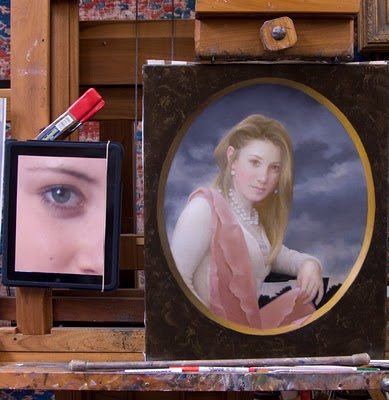If you have read much of this blog, you will have noticed that I dearly love gadgets.
The iPad is a little pricey so it took me a while to "talk myself" into getting one. However, had known how much it would help me in painting a portrait - I would have done it much sooner!

You're looking at the cheapest model iPad with the generic black case sold in the Apple Store. I applied a clear plastic to the surface to protect the screen.
I clipped it to my easel with an ordinary hardware store Electrician's Clamp and a rubber band holds the cover back.
The iPad screen has a very high resolution and I can - with a touch of a finger - enlarge and move a reference picture around very easily. I can paint 10+ hours without having to recharge this device. (I can also listen to music or audiobooks as I work).
The advantage of the iPod screen is that I can now see a variation of subtle tone - more than in any photograph I could ever print out.
This gadget is an ideal way to display reference photographs - and my portfolio.
It is is amazing to me how many of us artists have really poor vision. This gadget allows me to blow up any feature and actually SEE the structure.
I can paint faster, more easily and more accurately now - my only regret is that I didn't get an iPad much sooner.






















